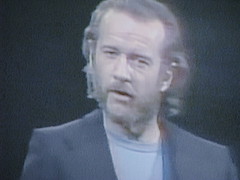Free speech and broadcasting: Cohen v. California and FCC v. Pacifica Foundation
By Kristopher A. Nelson
in
October 2011
900 words / 4 min.
Tweet
Share
Balancing strong First Amendment (“free speech”) speech protections with the desire to protect the delicate sensibilities of America’s youth is always a complex task. Two seminal Supreme Court cases-Cohen v. California and FCC v. Pacifica Foundation-illustrate the struggle the Court has had to find the right path.
Please note that this post is from 2011. Evaluate with care and in light of later events.

Balancing strong First Amendment (“free speech”) speech protections with the desire to protect the delicate sensibilities of America’s youth is always a complex task. Two seminal Supreme Court cases–Cohen v. California and FCC v. Pacifica Foundation–illustrate the struggle the Court has had to find the right path.
In Cohen, decided in 1971, the Supreme Court overturned the conviction of a man wearing a jacked in a courthouse that attacked the draft with a four-letter word (“Fuck the Draft”). In that case, Justice Harlan, writing for the majority, “one man’s vulgarity is another’s lyric,” and said that offended readers could simply turn away. A state has no right to ban profanity to maintain “civility.”
Nonetheless, in 1978 the court upheld fines imposed by the FCC on the owner of a New York radio station for broadcasting George Carlin’s “Filthy Words.” Why the difference? Is the medium of radio really so different that it requires different rules, ones that now do permit the state (in this instance, the federal government) to ban profanity? Or was Carlin’s speech in a different, less protected category than Cohen’s opinion on the draft?
The majority in FCC v. Pacifica Foundation sees no conflict with Cohen, and in fact cites Harlan’s vulgarity statement approvingly–but then proceeds to say that
content of that character [i.e., “vulgar,” “offensive,” and “shocking”] is not entitled to absolute constitutional protection under all circumstances, we must consider its context in order to determine whether the Commission’s action was constitutionally permissible.
Indeed, Cohen foresees this issue of considering the circumstances, and ties those circumstances to invasions of privacy interests, especially in the home:
The ability of government, consonant with the Constitution, to shut off discourse solely to protect others from hearing it is, in other words, dependent upon a showing that substantial privacy interests are being invaded in an essentially intolerable manner. Any broader view of this authority would effectively empower a majority to silence dissidents simply as a matter of personal predilections.
This is the exception seized upon most strongly by the majority in Pacifica Foundation:
Patently offensive, indecent material presented over the airwaves confronts the citizen, not only in public, but also in the privacy of the home, where the individual’s right to be left alone plainly outweighs the First Amendment rights of an intruder. Rowan v. Post Office Dept., 397 U. S. 728.
(Additionally, the Court also argues for the importance of protecting children–an argument that the Court in Cohen found unconvincing, but which the majority here thinks is quite important.)
In his concurrence, Justice Powell makes the case that broadcast media are uniquely capable of intruding on “unwilling adults … in their homes”:
The result turns instead on the unique characteristics of the broadcast media, combined with society’s right to protect its children from speech generally agreed to be inappropriate for their years, and with the interest of unwilling adults in not being assaulted by such offensive speech in their homes. Moreover, I doubt whether today’s decision will prevent any adult who wishes to receive Carlin’s message in Carlin’s own words from doing so, and from making for himself a value judgment as to the merit of the message and words.
Justice Brennan, though, strongly dissents, and attacks the majority for imposing its views of words and morality on the public at large:
the Court’s decision may be seen for what, in the broader perspective, it really is: another of the dominant culture’s inevitable efforts to force those groups who do not share its mores to conform to its way of thinking, acting, and speaking.
Brennan also argues that there is nothing so invasive about radio as a broadcast media that uniquely allows it to invade the home:
unlike other intrusive modes of communication, such as sound trucks, “[t]he radio can be turned off,”Lehman v. Shaker Heights, 418 U. S. 298,302 (1974)— and with a minimum of effort. As Chief Judge Bazelon aptly observed below, “having elected to receive public air waves, the scanner who stumbles onto an offensive program is in the same position as the unsuspecting passers-by in Cohen and Erznoznik [v. Jacksonville, 422 U. S. 205 (1975)]; he can avert his attention by changing channels or turning off the set.” 181 U. S. App. D. C. 132, 149, 556 F. 2d 9, 26 (1977).
In other words, for Brennan, there is nothing intrinsically different about radio. Unlike amplified sound–and like seeing a jacket with swear word on it–one can simply turn it off or turn away.
So–ignoring stare decisis–which approach do you find more persuasive? Is broadcast particularly invasive because it is transmitted into the home? Are children as a result particularly vulnerable? And what about the Internet, which while not a push medium like radio or TV, certainly enters the home?
